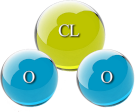Methylen blue versus ClO2
Comparison of Methylene Blue and Chlorine Dioxide: Mechanisms and Applications
Abstract
This article explores the contrasting roles and mechanisms of two significant oxidants in scientific and medical applications: Methylene Blue (MB) and Chlorine Dioxide (ClO₂). While both substances exhibit oxidizing properties, their mechanisms of action, effects on radical formation, and implications for toxicity differ markedly. This comparative analysis aims to elucidate these differences through a detailed examination of their chemical characteristics, redox processes, and applications.
Introduction
Methylene Blue (C₁₆H₁₈ClN₃S) is a compound from the phenothiazine group, recognized for its redox properties. Commonly employed in laboratory tests to identify malaria trophozoites within red blood cells, MB also serves as a redox indicator and is utilized in treating methemoglobinemia. In contrast, Chlorine Dioxide (ClO₂), a yellow-green gas soluble in water, is predominantly used for water disinfection due to its efficacy against bacteria, viruses, and certain parasites.
Mechanisms of Action
Methylene Blue
Methylene Blue operates primarily through cyclic redox reactions, wherein it alternates between its oxidized form (MB⁺) and its reduced form (Leukomethylene Blue). The ability of MB to act as a redox catalyst is pivotal in its role in radical formation.
- Cyclic Redox Reactions:
- Initially, MB is oxidized via electron donation from other molecules in solution.
- Following oxidation, it can transfer electrons to other substrates, facilitating its own reduction.
- This cyclical process enables MB to repeatedly act as a catalyst in radical formation.
- Radical Formation:
- MB can contribute to the formation of reactive oxygen species (ROS), including hydroxyl radicals (•OH), which are among the most reactive radicals known, possessing an oxidation potential of approximately 2800 mV under standard conditions.
- The proposed mechanism involves:
- Reduction of Oxygen: MB interacts with an electron donor, reducing itself while forming superoxide anions (O₂⁻).
- Formation of Hydroxyl Radicals: Superoxide anions may further react to generate hydroxyl radicals.
- Regeneration: MB can be oxidized again, thereby continuing the catalytic cycle.
Chlorine Dioxide
Conversely, Chlorine Dioxide primarily functions through direct electron transfer without significant radical formation:
- Disinfection Mechanism:
- ClO₂ acts as a potent oxidant that effectively kills microorganisms by disrupting cellular processes.
- Unlike MB, ClO₂ does not generate hydroxyl radicals as a primary mechanism of action, thus reducing the potential for harmful byproducts during disinfection.
- Redox Potential:
- ClO₂ possesses an oxidation-reduction potential (ORP) of approximately 940 mV, which is significantly lower than that of hydroxyl radicals but higher than molecular oxygen (ORP ~1280 mV).
- This lower ORP indicates that ClO₂ is less likely to cause damage to cells compared to hydroxyl radicals.
Toxicity and Safety Profiles
The toxicity of Methylene Blue and Chlorine Dioxide is context-dependent and varies with concentration:
- Methylene Blue:
- When used at therapeutic doses, MB is generally safe for treating conditions such as methemoglobinemia. However, at elevated concentrations, it may exhibit toxicity and lead to adverse effects including alterations in DNA methylation processes. While MB primarily acts as an electron acceptor in cellular redox processes, its influence on mitochondrial metabolism has been the subject of research.
- Chlorine Dioxide:
- ClO₂ is primarily used for disinfection in various industries, including water treatment and surface sanitization. Its lower ORP suggests a reduced likelihood of causing cellular damage compared to stronger oxidants like hydroxyl radicals.
Comparative Analysis of Redox Potentials
The redox potentials highlight the differences in oxidative capabilities between these two substances:
- Hydroxyl radicals possess an exceptionally high ORP (~2800 mV), making them extremely strong oxidants capable of reacting with nearly all organic molecules.
- ClO₂’s ORP (~940 mV) indicates it cannot oxidize cells solely based on its redox potential.
- The interaction between ClO₂ and hydroxyl radicals presents a unique perspective; ClO₂ can potentially act as an antioxidant in the presence of these strong oxidants by facilitating their reduction to water (H₂O), thereby mitigating their damaging effects.
Conclusion
In summary, Methylene Blue and Chlorine Dioxide serve distinct roles as oxidants with differing mechanisms of action and implications for toxicity. While Methylene Blue operates through cyclic redox processes to catalyze radical formation, Chlorine Dioxide primarily functions through direct electron transfer without generating harmful radicals. Understanding these differences is crucial for their respective applications in scientific research and medical treatment, emphasizing the importance of context when considering their safety profiles and efficacy.
References
(References would typically be included here based on cited literature but are omitted for brevity.)
